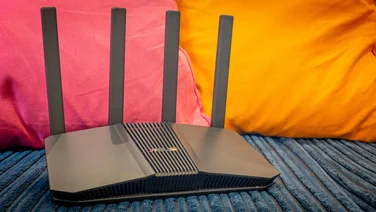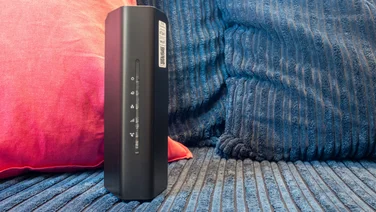To help us provide you with free impartial advice, we may earn a commission if you buy through links on our site. Learn more

We’ve been mightily impressed with Netgear routers many times before, and the 802.11ac-compatible R6300 is a particular favourite thanks to its high wireless speeds that reached up to 288.9Mbit/s in our tests. We were therefore hoping for good performance and features from the R6100, a dual-band 802.11ac-compatible router on sale for less than £80 with a theoretical top Wi-Fi speed of 867Mbit/s.
The 802.11ac standard allows for much higher wireless transfer speeds than the older 802.11 standard. However, 802.11ac only works on the 5GHz band, hence the need for 802.11ac routers such as the R6100 to be dual band. Many Wi-Fi devices only work on the 2.4GHz band, so by providing Wi-Fi networks on both the 2.4GHz and 5GHz bands the R6100 allows those with older and newer devices to connect to a network wirelessly without trouble. This means that even if you don’t have an 802.11ac-compatible device at the moment you can still use the R6100 with your older smartphones, tablets, laptops and so on.
GENIE OUT OF THE BOTTLE
We’ve always found Netgear routers to be easy to set up and configure, and the R6100 is no exception. The included instructions are clear, and you can use the Netgear Genie app for iOS and Android to configure the router should you not have access to a PC. We tested Genie with an iPhone 4S and had no trouble configuring a new name (SSID) for the wireless networks and a new password. The Genie app will even show you a map of your network and let you configure a guest network so that visitors to your home or office can access the internet but not other devices on your network.
Of course, you can configure the R6100 with a PC via its web interface, too. The R6100’s web interface is clear and pretty well organised, but there isn’t as much onscreen help as we’d like. IF you’re in any familiar with routers then you’ll quickly be able to find the settings and options you want to change, but casual users may need to read the instruction manual first.
Once set up, you can connect to the R6100 via Wi-Fi or an Ethernet cable. The R6100 has four Ethernet ports, but we were deeply disappointed to see that they’re Fast Ethernet ports. This is because the fastest speed you can push through a Fast Ethernet port is around 93.2Mbit/s, and 802.11ac speeds are typically in excess of that. This means you won’t get the best possible speeds if you’re streaming data from a Gigabit Ethernet-enabled NAS enclosure that’s connected to one of the R6100’s Fast Ethernet ports, to an 802.11ac device.
We were also disappointed to see that the R6100 didn’t perform too well in our Wi-Fi tests. When we connected to the R6100 on the 2.4GHz band with our laptop’s built-in Wi-Fi adaptor we saw wireless transfer speeds of 72Mbit/s at one metre, 25.7Mbit/s at 10 metres and 7.6Mbit/s at 25 metres. The result at one metre isn’t too bad, but the 10 and 25 metre results are much lower than we’d expect to see. Indeed, the similarly priced Trendnet TEW812-DRU, which is also an 802.11ac router, produced speeds of 81.3Mbit/s at one metre, 60.1Mbit/s at 10 metres and 16.8Mbit/s at 25 metres, which are much better results.
Predictably, we saw the best results when using the less congested 5GHz band, and we achieved transfer speeds of 93Mbit/s at one and 10 metres, and 90Mbit/s at 25 metres. The former scores are limited by the R6100’s Fast Ethernet ports. Had they been Gigabit Ethernet ports we’d have seen even higher speeds.
We also tested the R6100 with the Netgear A6200 Wi-Fi adaptor (£45 from www.scan.co.uk), and the transfer speeds were 93.2Mbit/s from one to 25 metres because of the limitations imposed by the Fast Ethernet ports. 93.2Mbit/s at 25 metres isn’t bad, but it’s a disappointing score in the context of an 802.11ac router and it’s clear that the transfer speeds could have been higher had the R6100 had Gigabit Ethernet ports.
READY TO SHARE
The R6100 lets you attach USB drives so that you can share their contents with others on your network, and behaves like a rudimentary NAS device. The R6100 even has a built-in DLNA media server, which means that you can stream pictures, videos and music stored on an attached USB drive to a computer or media streamer. We had no trouble streaming music to our iPhone 4S using the Netgear Genie app at a distance of around 15 metres, but pictures took a little while to load and Full HD videos took a long while to buffer. Even so, the media server and NAS features are good to have and it isn’t difficult to make use of them.
The Netgear R6100 is easy to set up and administrate, but we’re not happy with its 2.4GHz and 5GHz performance, or its Fast Ethernet ports. We much prefer the Trendnet TEW-812DRU, which has Gigabit Ethernet ports and higher transfer speeds. Its web interface isn’t as pretty or easy to use, but we think that’s a price worth paying for superior performance.






